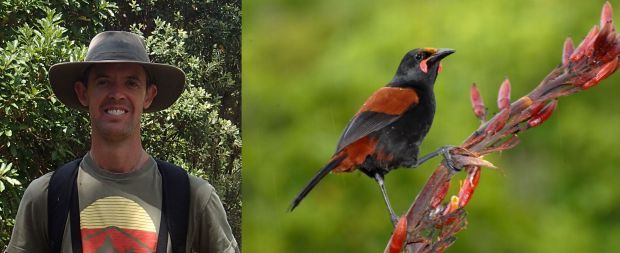
Kevin Parker, and an adult North Island saddleback with flax pollen on head (bird image © Peter Reese, from nzbirdsonline.org.nz)
North Island saddlebacks - or tieke - are one of New Zealand’s conservation success stories. By the 1960s they were found on just a single island, Hen Island in the Hen and Chicken group near Whangarei. Since then they’ve been successfully moved to a number of different islands and mainland sanctuaries. And, as birds were moved from one island to another, biologists noticed that interesting changes to their songs were taking place.
Alison Ballance heads to Tawharanui Regional Park, north of Auckland, to meet some saddlebacks - and song bird expert and independent scientific consultant Kevin Parker who fills her in on what’s happening. Kevin carried out PhD and post-doctoral research at Massey University on the evolution of saddleback song, and is very interested in bird translocations. In March 2012 Kevin and the Tawharanui Open Sanctuary Supporters organized a translocation of 90 saddlebacks to the park, and designed it to be a natural experiment that would both maximize the genetic diversity of the founder population, and also enable Kevin to follow what happened when three different song lines were combined. The translocation involved 30 birds from each of Lady Alice Island, Red Mercury Island and Mokoia Island – these populations have different lineages and each represent a different order of translocation from the ancestral population on Hen Island.

Tawharanui Regional Park (image: A. Ballance)

